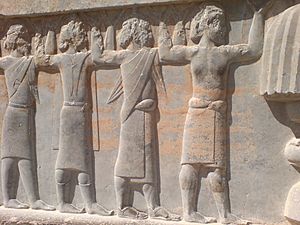Satrap facts for kids

A satrap was the name given to the important governors of the provinces in the ancient Median and Achaemenid (Persian) Empires. Think of them as powerful leaders in charge of a big region, reporting to the king.
Contents
What Was a Satrap?
A satrap was a high-ranking official. They were chosen by the king to manage a large part of the empire. These areas were called satrapies, which were like big states or regions. The word "satrap" comes from an Old Persian word meaning "protector of the land."
Role of a Satrap
Satraps had many important jobs. They were responsible for keeping peace and order in their province. They also collected taxes for the king. Satraps were in charge of the local army and made sure laws were followed. They even had their own courts to settle disagreements.
Why Satraps Were Important
The Persian Empire was huge, stretching across many different lands. It was too big for one king to manage alone. Satraps helped the king rule by taking care of local matters. They made sure the king's orders were carried out far from the capital city. This system helped the empire stay strong for a long time.
History of Satraps
The idea of satraps started with the Medes, an ancient Iranian people. When the Persian Empire grew, especially under Cyrus the Great and Darius the Great, they used the satrap system even more. Darius I divided his empire into about 20 satrapies. Each had its own satrap.
How Satraps Were Chosen
Satraps were usually chosen from the Persian nobility. This meant they came from important families. The king would appoint them directly. To make sure satraps stayed loyal, the king often sent special inspectors. These inspectors were called "the King's Eyes and Ears." They would report back to the king about how the satrap was doing.
Famous Satraps
Many satraps played important roles in history. Some were very loyal to the king. Others tried to become independent rulers themselves.
Themistocles
One interesting example is Themistocles. He was a famous general from Athens, Greece. After being exiled from Athens, he became a satrap for the Persian king. He ruled the region of Magnesia in Asia Minor. This shows how the Persian Empire sometimes used talented people from other lands.
Alexander the Great and Satraps
When Alexander the Great conquered the Persian Empire, he also used the satrap system. He appointed his own generals and some local leaders as satraps. This helped him control the vast lands he had conquered. After Alexander's death, his generals, known as the Diadochi, divided his empire. They continued to use satraps to rule their new kingdoms.
Satraps in Later Empires
The idea of satraps didn't end with the Persian Empire. Later empires, like the Seleucid Empire, also used similar systems. Even the Western satraps in India, much later, were powerful local rulers. This shows how effective the satrap system was for managing large territories.
Images for kids
-
The Herakleia head, probable portrait of an Achaemenid Empire Satrap of Asia Minor, end of 6th century BCE, probably under Darius I
-
A dignitary of Asia Minor in Achaemenid style, circa 475 BC. Karaburun tomb near Elmalı, Lycia
-
Coin of Themistocles, a former Athenian general, as Achaemenid Empire Satrap of Magnesia, circa 465–459 BC
-
Banquet scene of a Satrap, on the "Sarcophagus of the Satrap", Sidon, 4th century BC
-
Bagadates I (Minted 290–280 BC), the first indigenous satrap to be appointed by the Seleucid Empire
-
Coin of "Western Satrap" Nahapana, circa 120 CE
See also
 In Spanish: Sátrapa para niños
In Spanish: Sátrapa para niños










